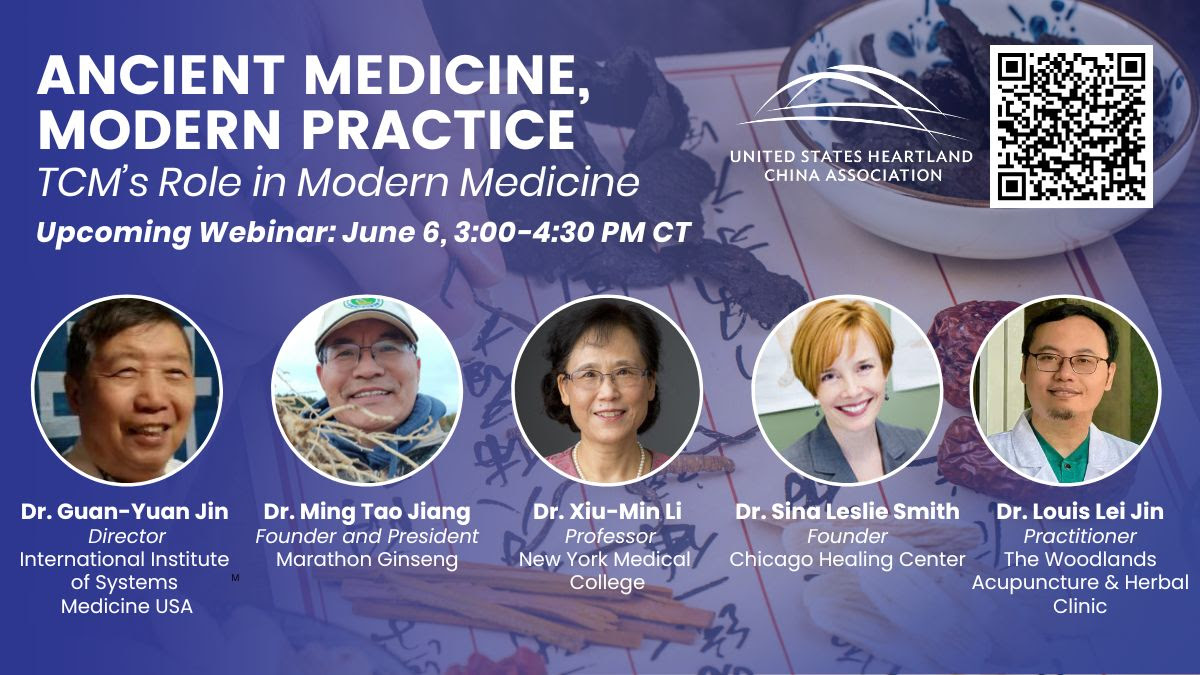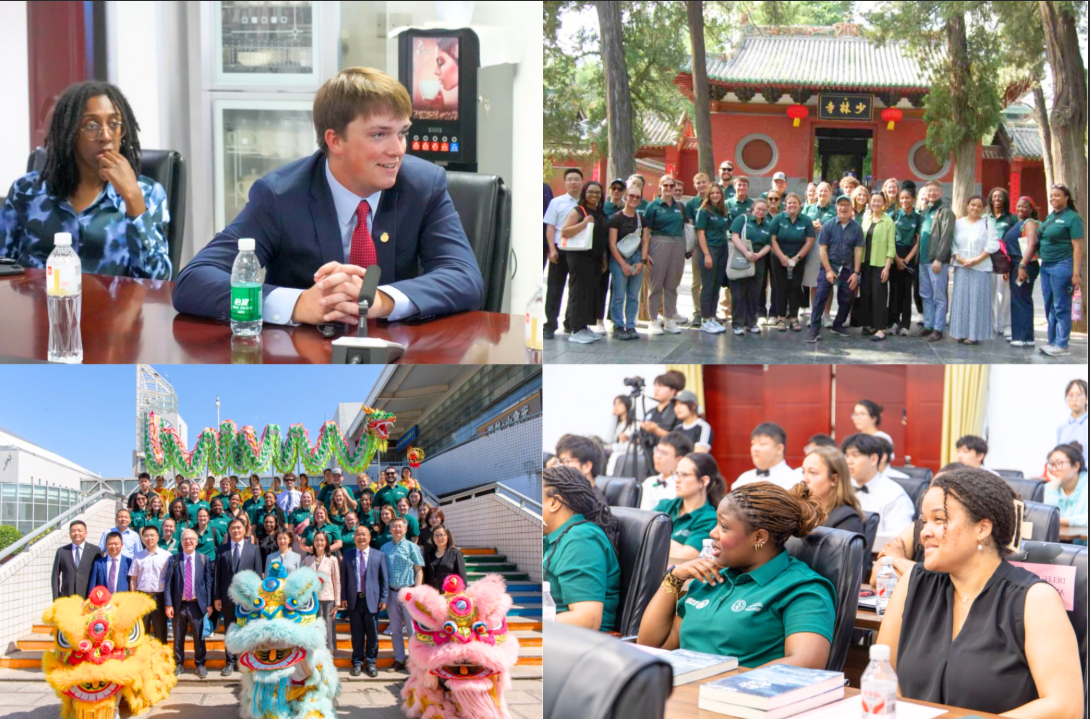
June 15, 2025 04:00 PM La Paz
Discover how Traditional Chinese Medicine (TCM) bridges ancient wisdom and contemporary healthcare in this illuminating webinar. Join leading experts from the U.S. and China as they explore TCM’s integrative potential in addressing today’s critical health challenges—with a focus on improving care for rural and underserved communities. Learn how blending time-honored practices with modern medicine can enhance outcomes and expand access to holistic healing.
Contact the US Heartland China Association at contact@usheartlandchina.org to register.
The Future Agriculture Leaders Delegation to China, organized by the U.S. Heartland China Association (USHCA) successfully completed a week-long learning trip to China from June 1-8.
During the trip, the 21 student delegates had the opportunity to engage with agricultural experts and explore how global markets can help American agriculture thrive.

Is grassroots spontaneity the final cure for China's football (and all soft powers)? (china-translated.com)
I believe two important factors contribute to Jiangsu City League’s peculiar popularity.
First, it’s not an official game. It’s amateur, spontaneous, bottom-up, and undictated. And that’s the basic requirement for fun. Despite a culture that generally centers on conformity, Chinese people know what fun is. In that, they are just like every human being on earth.
Second, one also has to consider the peculiar nature of Jiangsu.
Many Chinese people know that the province of Jiangsu is really strange. If someone comes from Shandong, very likely they will call themselves a “山东人Shandonger.” Sichuan, the Sichuanese. Hunan, the Hunanese. The most extreme example is Dongbei, a huge region made of 3 provinces and formerly known as Manchuria. Dongbei people usually just introduce themselves as Dongbei’er, regardless of the province from which they came.
But Jiangsu is strange, in that it’s maybe the only province in China that when its residents introduce themselves to outsiders, they almost never say they are “Jiangsu’er”, but usually just say the city, and sometimes even the county they came from, like Nanjing'er, Suzhou’er, or Taicang’er. (To understand China’s administrative layers, I highly recommend this primer by the always wonderful, Mr.
David Fishman.)
This allegiance to the city, not to the province, stems from the fact that different cities in Jiangsu belong to different subcultures.
China greenlights mega-project canal linking resource-rich Jiangxi to wealthy Zhejiang | South China Morning Post (scmp.com)
A new 767-kilometre-long canal linking the inland rare earth hub of Jiangxi province with the eastern coastal powerhouse of Zhejiang has officially been included in the government’s agenda, according to a recently released policy document, as the Chinese government steps up efforts to expand its inland waterway network.
China already boasts a sprawling web of high-speed rail and highways that reach deep into nearly every corner of the country, but officials have increasingly turned to rivers and artificial waterways – part of a broader push to lower logistical costs and integrate less-developed inland regions with wealthier coastal hubs, analysts said.
The Jiangxi-Zhejiang Canal is part of a mega-project aimed at connecting Guangdong, Jiangxi and Zhejiang by water. It is expected to become the most expensive artificial canal ever built in China, with an estimated investment of 320 billion yuan (US$44.4 billion), nearly three times that of the Hong Kong-Zhuhai-Macau Bridge.
On this Chinese island, patients are trying latest experimental drugs for cancer | South China Morning Post (scmp.com)
A medical revolution quietly unfolds on Hainan, allowing patients to access cutting-edge therapies before they hit the market.
Beneath the swaying palms of Hainan, China’s tropical southernmost island province, a quiet revolution is unfolding.
In the secluded town of Lecheng, a 50-year-old woman sits in a sunlit hospital room, her gaze steady as a nurse administers an injection that could rewrite her future.
Diagnosed with early-stage lung cancer, she is among the first patients in China to receive the LK101 injection – a personalised mRNA vaccine designed to slash the risk of relapse….
Becoming Ma Jingfen - by Jiang Jiang and Yifei Shi (gingerriver.com)
It’s about Ma Jingfen, a 93-year-old Chinese entrepreneur whose life has unfolded across the dramatic arcs of China’s modern history. For a long time, she was recognized mainly as the wife of Zhu Shijian — the man known as China’s “tobacco king” — but in recent years, she has quietly stepped into the spotlight in her own right.
Huawei’s HarmonyOS gains traction in China with 103 million smartphones shipped | South China Morning Post
Huawei Technologies has shipped more than 103 million smartphones and 21 million tablets running its proprietary HarmonyOS operating system, with nearly half delivered in 2024, according to consultancy Canalys.
The Shenzhen-based technology giant shipped 46 million smartphones and 10.5 million tablets last year, signalling an accelerating pivot to its in-house operating system, serving as an alternative to Google’s Android amid US sanctions.
Huawei has been transitioning its devices to its own OS since 2021, ramping up efforts after Washington placed the company on its Entity List in 2019 over national security concerns. The privately held firm has since expanded HarmonyOS beyond smartphones and tablets, launching two laptops running on the system last month.
China’s megaprojects and their significance | South China Morning Post
Chinese engineering has achieved remarkable feats over the years, delivering some of the most extraordinary infrastructure projects in the world.
Since the early 2000s, when China harnessed the power of the Yangtze with the monumental Three Gorges Dam, the nation has continued to push the boundaries of innovation.
Two decades later, China is constructing a mega-dam in the Earth’s deepest canyon. One capable of generating three times the power of the Three Gorges.
From awe-inspiring bridges and trailblazing space projects, China’s engineering prowess has led to some of humanity’s most jaw-dropping achievements.
In the span of a single generation, China has redefined the limits of civil engineering, transforming itself from a nation reliant on foreign bridge-building expertise to the undisputed architect of the world’s most audacious crossings.
Across mist-shrouded gorges, typhoon-whipped straits and sprawling urban megaregions, Chinese engineers are erecting structures that defy geography while smashing world records.
A study published in China’s Journal of Transport Science and Engineering reveals the scale of this metamorphosis. By 2030, the world’s longest suspension spans, tallest crossings and every record-holding cable-stayed megastructure will bear the imprint of Chinese civil engineers, it said.
Why turning 35 feels like a career ‘death sentence’ for some Chinese tech workers | South China Morning Post
While China’s rapid development has brought remarkable benefits to its society, it has also given rise to some troubling issues. One such challenge is the “curse of 35”, where individuals over the age of 35 face discrimination and struggle to find opportunities in the nation’s highly competitive job market.
Employers prefer younger, energetic candidates with fewer family commitments as they are perceived as more motivated and cost-effective. Could this be one of the reasons behind China’s declining marriage rates?
China’s solar PV makers seek antidote to market ills as glut, price war, Trump tariffs sting | South China Morning Post
China’s solar photovoltaic (PV) manufacturers are looking for solutions to years of price wars and losses at home amid excess capacity and waning demand as executives gathered in Shanghai to discuss the problems crippling the industry.
They will get a chance to gauge the crisis as the financial hub plays host to the SNEC PV+ Photovoltaic Power Conference and Exhibition from Tuesday to Friday. The conference is the largest of its kind, attracting some 3,000 enterprises from more than 100 countries, according to its organisers.
“The solar PV industry isn’t a zero-sum game,” Zhu Gongshan, chairman of the Asian Photovoltaic Industry Association and one of the event organisers, said in his keynote address on Tuesday. “We are all in this together. Extreme cost-cutting and fierce competition are not different from drinking poison to quench thirst.”
Chinese teen’s suicide puts crushing academic pressure in the spotlight | South China Morning Post
A heart-wrenching suicide note left by an 18-year-old girl who killed herself in April has reignited discussion online about the heavy academic burden placed on children in China.
In the letter, the girl – who was in her final year at a top high school in Bengbu, a city in the central province of Anhui – wrote about the pressure she felt to do well and said she had been broken by relentless exams, particularly maths and physics.
“I cannot bear how you meticulously checked the scores of all the examinations and tests. I cannot bear how my scores appeared frequently in the text messages between you and your friends and relatives. But then you were afraid that I might see them and you secretly deleted them afterwards,” the girl said in the letter written on the back of school test sheets, which was posted on social media recently.
Chinese students reconsider UK degrees as fees rise, visa rules tighten | South China Morning Post
After she graduated last summer, Aroma Wu quickly realised that if she wanted a career in China’s tech industry, she would need to go back to school: her bachelor’s degree simply was not enough.
“I saw how competitive it was – most people had a master’s,” the 24-year-old said.
To boost her credentials, Wu decided to apply for a graduate programme in the United Kingdom, and she soon received an offer. But within weeks, she was growing worried by news coming out of Britain – and starting to rethink her decision.
Why Hong Kong is China’s undisputed hub for global finance, at Shanghai’s expense | South China Morning Post
When Yan Jun was looking around last year for a stock market to raise capital for his Beijing-based traffic-control software company, the engineer and chairman thought he was spoiled for choice.
He could sell shares of his 10-year-old company AICT on one of the three mainland exchanges – Beijing, Shanghai and Shenzhen – that together make up the world’s second-biggest capital market, with a combined value of US$10 trillion, according to Bloomberg data.
Or he could raise capital offshore by selling shares in Hong Kong’s nearly US$6.2 trillion market, the world’s fourth-largest.
This weekly newsletter is put together by DeLisle Worrell, President of the ABCF. Visit us at Association for Barbados China Friendship | (abcf-bb.com).
Thanks to everyone who sent contributions for this week’s Update. Please send items of interest to me via the contact page at ABCF-BB.com or to info@DeLisleWorrell.com